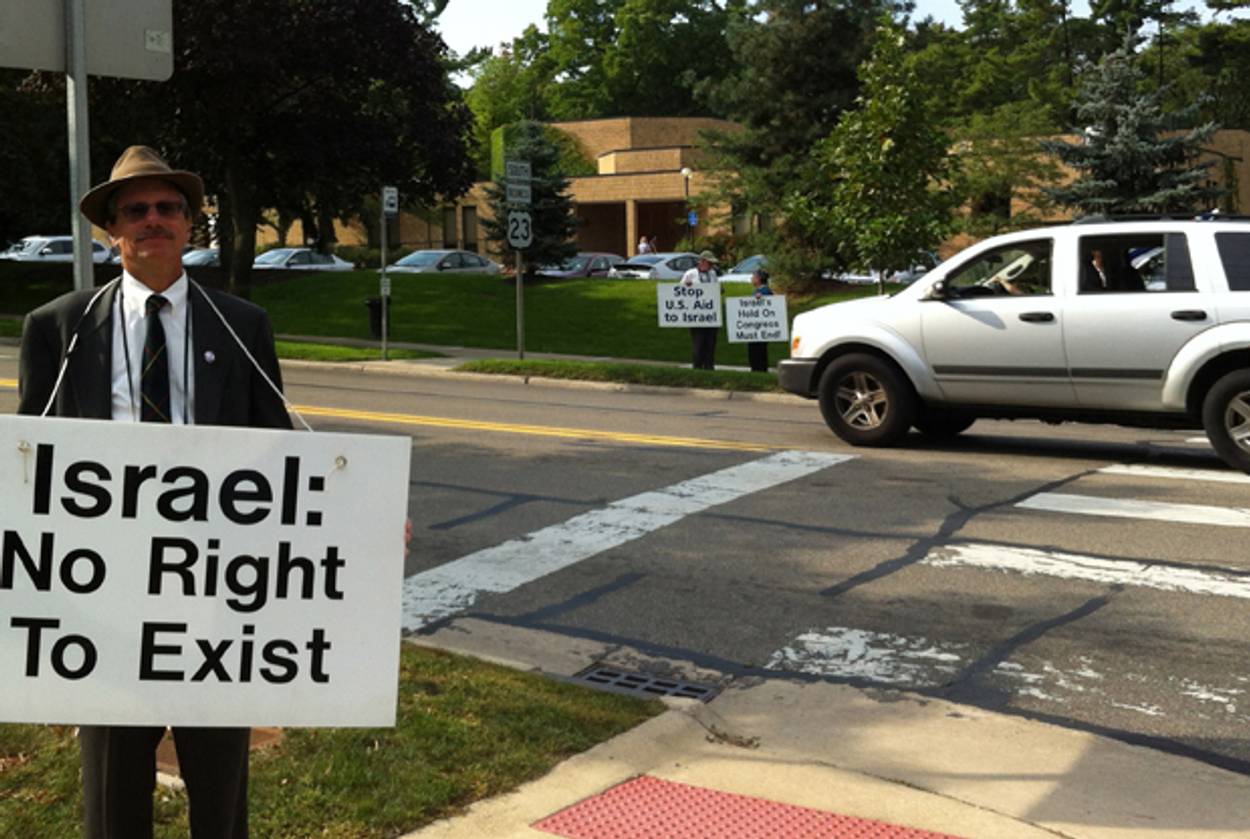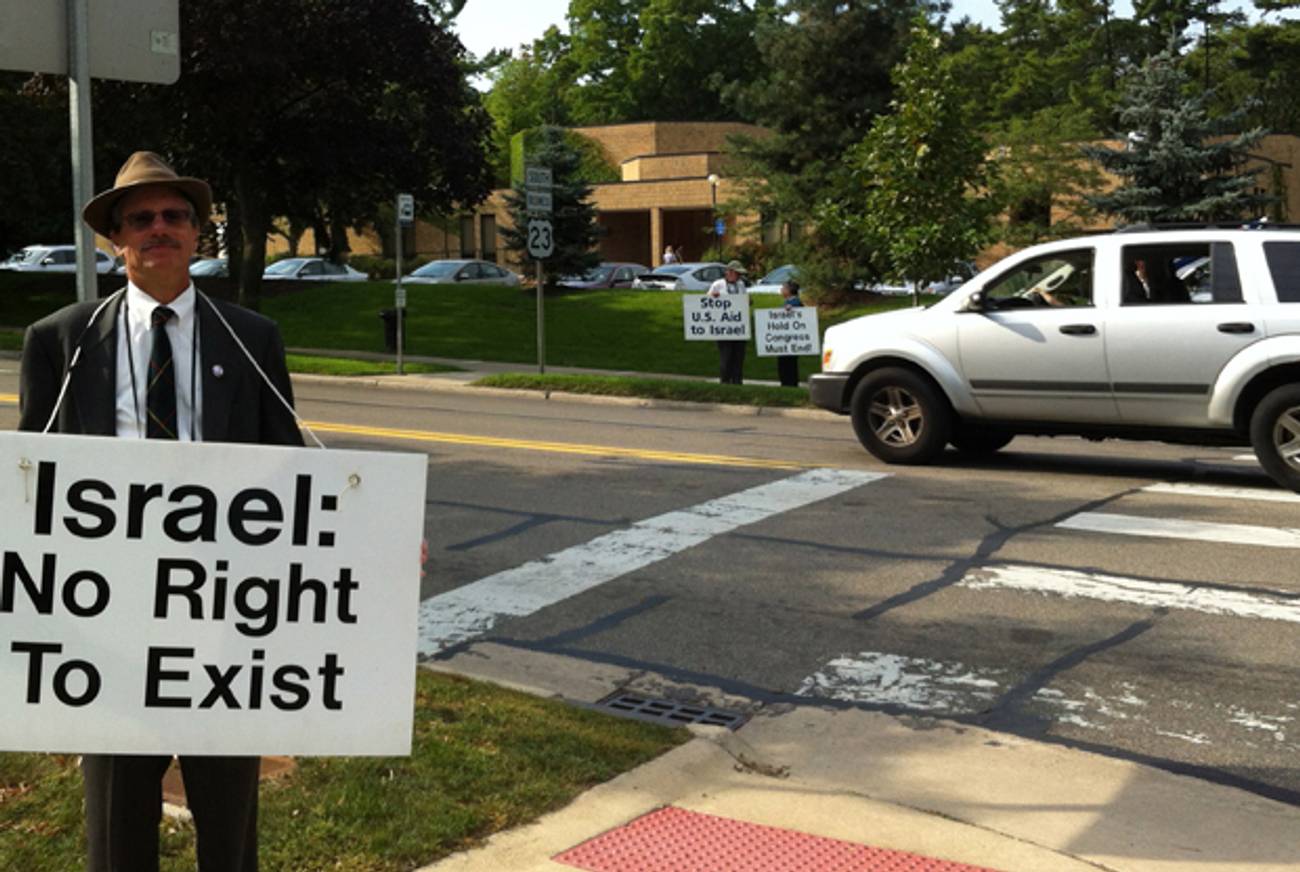500 Days of Protest in Ann Arbor
On Yom Kippur, anti-Israel group celebrates 10th anniversary of shul picket




For more than 500 Saturdays, Henry Herskovitz has paced the sidewalks outside Temple Beth Israel in Ann Arbor, Mich., with placards reading “Israel: No Right To Exist” and “Is Ethnic Cleansing A Judaic Value?” hanging from his neck. His fellow protesters—most of them septuagenarian and octogenarian retirees, many of them former labor activists—wave doctored Israeli flags, with red lines crossing out the Star of David in the middle, and solicit honks from passing motorists.
This week, the group—known as Jewish Witnesses For Peace and Friends even though Herskovitz is its only regular Jewish participant—marks the tenth anniversary of its 75-minute Shabbat vigils outside the synagogue, which may be the longest-running and most frequent anti-Israel demonstrations in North America. Almost every Shabbat since Sept. 13, 2003, they have appeared at this corner on Washtenaw Avenue decrying the synagogue as an agent of Palestinian oppression. The anniversary coincides with Yom Kippur, when the synagogue will host many more congregants than on a usual Saturday—but to Herskovitz it’ll be another Saturday and another vigil.
On its face, the effort looks like any of the now-routine pickets of pro-Israel events including the annual American Israel Public Affairs Committee conference in Washington by Code Pink. But Herskovitz’s efforts are rooted in an old-fashioned intra-faith grudge: In 2003, the synagogue refused to let him present a slideshow of photographs he’d taken at a Palestinian refugee camp that he felt documented human rights abuses. Incensed, he turned to local pro-Palestinian groups for support. “He was madder than a rooster about his disagreement with the rabbi and he wanted people to stand with him,” recalled Gloria Harb, a 71-year-old retired bookkeeper for Chrysler who routinely participates in protests. “He was going to do something, not just have a meeting. We figured one or two Saturdays and they’d let him in just to get us off the streets. But they never did. It just got bigger and bigger.”
Beth Israel’s rabbi, Robert Dobrusin, said he rejected the original request because he didn’t know what context Herskovitz planned to use for his presentation. “If what’s happened since then is any indication, I was right,” Dobrusin said this week. Like Herskovitz, he did not initially expect the demonstrations to persist for long. He said he offered to sit down with Herskovitz on the condition that the vigils be suspended. “That was more than nine years ago,” the rabbi told me.
Herskovitz, for his part, first called on Beth Israel to denounce Israel’s existence, and now promises they’ll stand down if Dobrusin removes the Israeli flag from the sanctuary. A native of Pittsburgh’s Squirrel Hill, Herskovitz has lived in Ann Arbor since attending University of Michigan for an engineering degree in the 1960s. He says he attended High Holiday services at Beth Israel before Dobrusin’s 1988 hire, but now he spends Yom Kippur each year taunting fasting worshippers by dubbing it International Eat-a-Cheeseburger Day. “I don’t mean to be rude about this, but I came to the synagogue and said, ‘Let me talk about this,’” he says. “They said no. I said, ‘OK, I’m going to stand here.’ Seems like the ball’s in their court. If you don’t like what we’re doing and you want us to leave, what are you willing to do to get what you want?”
Not much. Dobrusin regards Herskovitz’s demands as absurd and, while acknowledging personal anguish over the demonstrations, insisted he won’t negotiate with them. “We’re not going to change our policies, we’re not going to change the things that we do, that we believe in because somebody else doesn’t like it. … People have gotten used to it, it’s no surprise anymore. But it isn’t quite as simple as that because when we have a bar or bat mitzvah or people who come from out of town, we have to be concerned about how they’re going to view it.”
Herskovitz’s demonstrations sometimes draw more than 15 fellow picketers, although he dislikes that term because he believes picketing implies they want to stop worshippers from attending synagogue. He and his group are scrupulous about staying off synagogue property and not obstructing anyone’s ability to come and go—just as the synagogue has been scrupulous about respecting Herskovitz’s First Amendment right to carry on protesting. Which isn’t to say that everyone does: Last weekend, a passerby cursed at the protesters and uprooted some of their sidewalk signs, prompting a cursing Herskovitz to whip out a camcorder in an attempt to capture the vandal’s face for his blog. “I’ve gotta keep it more in check,” Herskovitz said, reigning in his irritation.
But even many who are sympathetic to the plight of the Palestinians regard Herskovitz’s group as an embarrassment. Imam Dawud Walid, executive director of the Council on American-Islamic Relations in Michigan, denounced the protest to The Arab American News, noting: “We’d be hypocrites to say it’s not civil in front of mosques yet to endorse it taking place at other houses of worship… There’s a time and place for everything, and it would not be fitting for us as Muslims to protest in front of Jewish synagogues on the Sabbath day.”
Others point out that Dobrusin is a poor target, because the rabbi has been outspoken in his support for a two-state peace settlement. “The rabbi is one of the most outspoken for addressing full equality for Arab citizens,” said Ann Arbor City Councilman Chuck Warpehoski, director of the local Interfaith Council, which has condemned Herskovitz and his followers. “That’s his dream for what Israel should be. We’re talking about one of the people most willing to be critical of Israeli policy and he’s the one who’s targeted for this kind of abuse. It boggles the mind.”
The criticism merely emboldens Herskovitz, who insisted the real victims have been his group and the Palestinian people. Herskovitz rattled off a list of incidents in which his supporters have been threatened, harmed or robbed while demonstrating, although he also claims the vast majority of motorists who honk are doing so in support. In an e-mail, he insisted “the unwillingness of elected officials to prosecute these crimes” should “play a significant role” in this report. Harb, for instance, said she was smacked on the back while setting up signs one Saturday, a case that was dismissed in court after a police report.
Yet much of the enmity is firmly directed at Herskovitz. “He’s told me on more than one occasion that whatever happened to the Jews in World War II, they brought it upon themselves,” said Victor Lieberman, a congregant and UM history professor. Herskovitz was happy to elaborate on his disputes with Lieberman when asked about those confrontations. “I said it’s incumbent upon Jews to understand why they were hated and why they were treated so badly not only in Germany but other places,” he said. “For one thing, the Bolsheviks from Russia were coming into Germany and Hitler feared the Bolsheviks, which were dominated by Jewish leadership. So he looked around and said, ‘Well, I have all these Jews in Germany.’ It’s like the Japanese-Americans in World War Two, we didn’t trust them so we rounded them up. That’s what Hitler did.”
Such commentary, while historically suspect and abhorrent to most Jews, has made Herskovitz a celebrity of the anti-Israel fringe. Michael Rabb, a Palestinian activist in Boulder, Colo., has tried to emulate the Ann Arbor demonstrations outside of Bonai Shalom—a Conservative egalitarian congregation—but has only been able to draw four or five collaborators for six protests over the past year, he said.
It remains unclear to Herskovitz and his group how long the vigils will continue. Herskovitz, at 67, is the second youngest of the regulars, and three members have died in recent years. “We have to take a hard look at our group,” Harb said. “I’m not sure what’s going to happen throughout the winter because some of our people are getting frailer.” The youngest of them, a 63-year-old named Thom Saffold, politicized the point by saying: “I’m afraid we’re going to die out before Israel ends the occupation.”
One person who hopes the occupation ends long before that is Dobrusin. But if not, he said the congregation will carry on as best they can. “When I think of myself as a rabbi, of how many other things I could do if I didn’t spend hours talking about this, it’s very, very difficult,” he said. “But here we are. This is sad. This is a shame. This is difficult. But we live in a community that takes this issue seriously, where people are passionate. There’s a whole lot of positive to that.”
Steve Friess is a former senior writer for Politico who lives in Ann Arbor, Michigan.